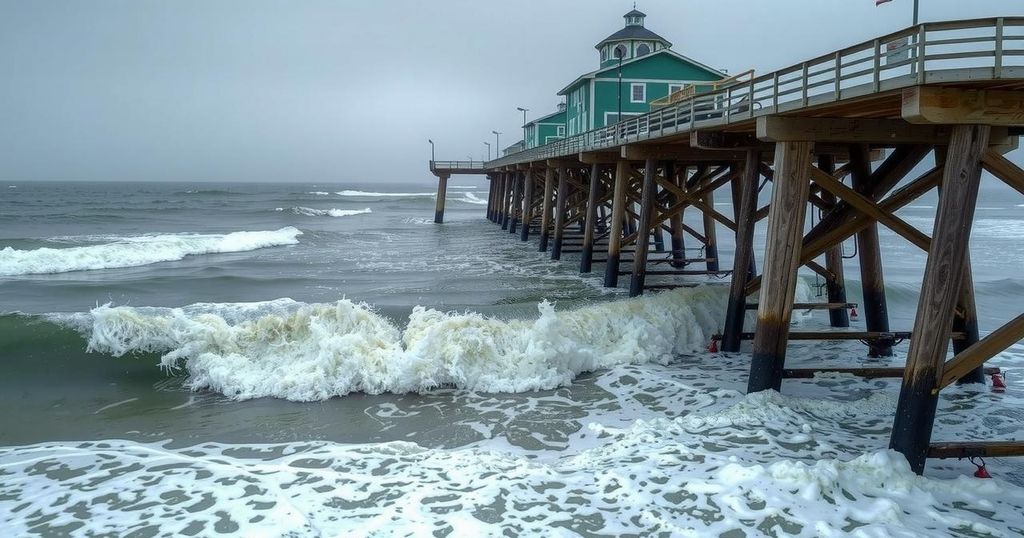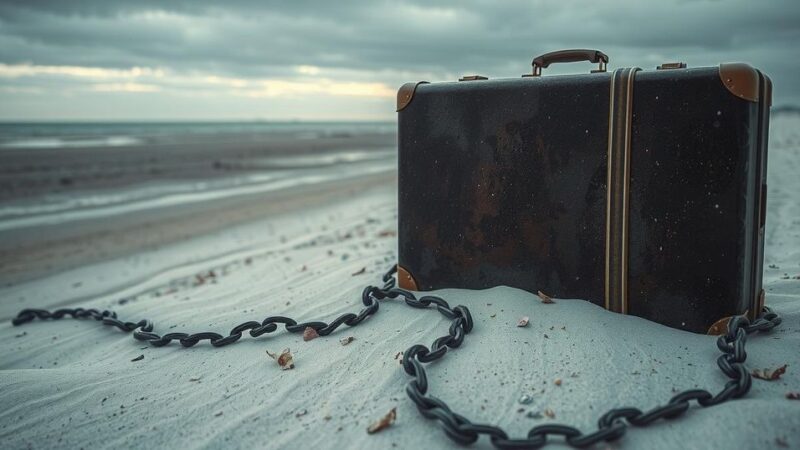A powerful storm struck California’s central coast, causing severe flooding and high surf, leading to one man’s death and the partial collapse of a pier in Santa Cruz, endangering three individuals. Authorities issued coastal flood warnings and ordered evacuations as conditions are expected to worsen.
On Monday, California’s central coast experienced a significant storm, resulting in severe flooding and high surf that tragically led to the death of a man who became trapped under debris on a beach. This weather phenomenon also caused the partial collapse of a pier in Santa Cruz, endangering three individuals who fell into the Pacific Ocean. The event prompted evacuations of beachfront properties and heightened warnings from the National Weather Service about the intense conditions expected to persist through the coming days.
The storm’s intensity was notable, with hurricane-force winds and waves projected to reach up to 60 feet in height. In response, the National Weather Service issued a coastal flood warning set to remain in effect until noon on Tuesday, accompanied by a high surf warning until evening of the same day. Fred Keeley, the Mayor of Santa Cruz, expressed concerns regarding the escalating severity of the storm, indicating that its impacts were predicted to intensify throughout the day.
A response team was summoned to Sunset State Beach in Watsonville following reports of a man trapped by debris, likely caused by a large wave. Unfortunately, the man succumbed to his injuries and was pronounced dead at a local hospital. Concurrently, another individual was swept into the ocean at Marina State Beach, prompting a search effort by the US Coast Guard and California Highway Patrol, which was ultimately suspended due to perilous conditions.
In Santa Cruz, the municipal wharf that was undergoing renovations partially collapsed, resulting in three individuals tumbling into the water. Quick action by lifeguards and a self-rescue by one other individual ensured that there were no serious injuries reported. The incident raises significant concerns regarding the structural integrity of other parts of the wharf, particularly as inspections are underway post-collapse.
The coast endured hazardous surf conditions and considerable wind speeds, reinforcing the necessity for safety measures. According to the National Weather Service, a high surf warning remained in effect, as surf conditions along the Oregon coast were also expected to be dangerous. Overall, the storm’s impact has highlighted the dangers associated with severe weather events, underscoring the importance of preparedness and timely warnings.
The storm that swept across California’s central coast on Monday represented a major weather event, characterized by intense flooding, dangerously high surf, and powerful winds. The area was already under renovation from previous storm damages, illustrating the ongoing vulnerability of coastal infrastructures to extreme weather. This situation serves as a reminder of the risks posed by natural calamities, especially as climate change continues to influence weather patterns.
In summary, the major storm impacting California’s central coast has resulted in tragic loss of life, injuries, and damage to infrastructure, including a partially collapsed pier in Santa Cruz. Evacuations were implemented in anticipation of heightened dangers, and safety alerts were issued in response to the storm’s potential consequences. These events underline the critical importance of preparedness and public safety measures during extreme weather.
Original Source: www.cnn.com






